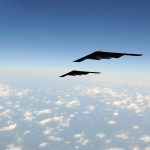
The basis of American naval power is quite simple: the U.S. Navy is utterly unchallengeable. The core of the force are the massive supercarriers, each of which carry dozens of long-range fighter-bomber jet aircraft. Each supercarrier carries more offensive firepower – even without nuclear weapons – than all but a small handful of countries, and since they are by definition mobile, they all boast a combat range that is quite literally global.
And America’s supercarriers don’t go anywhere alone. They prowl the seas with a host of support vessels that form as-yet-unassailable battle groups. The combined blue water fleets of the rest of the world would do extremely poorly in open battle against but two of these American fleets.
The carrier depicted here, the Enterprise, was the most powerful naval vessel ever to sail the oceans. Emphasis on the word was. The Enterprise has been long obsolete, having been overtaken and replaced by the ten Nimitz-class vessels that in 2014 form the backbone of American naval power. Now even the mighty Nimitzes are being phased out in favor of the faster and more powerful Ford-class carriers.
There now is only one non-U.S. supercarrier in the world: France’s Charles de Gaulle. Unfortunately for the French, the de Gaulle has been so plagued with technical problems in its 13 years of operation that it only rarely sets to sea, and only then for brief exercises. The British’s Queen Elizabeth class will launch in 2020, and is likely to use American aircraft – as well as American pilots – until its own next-generation carrier-capable jets become available sometime in the 2020s.
For more on the nature of naval power and how it will evolve during the next two decades, see Chapters 3 and 8 of The Accidental Superpower.




